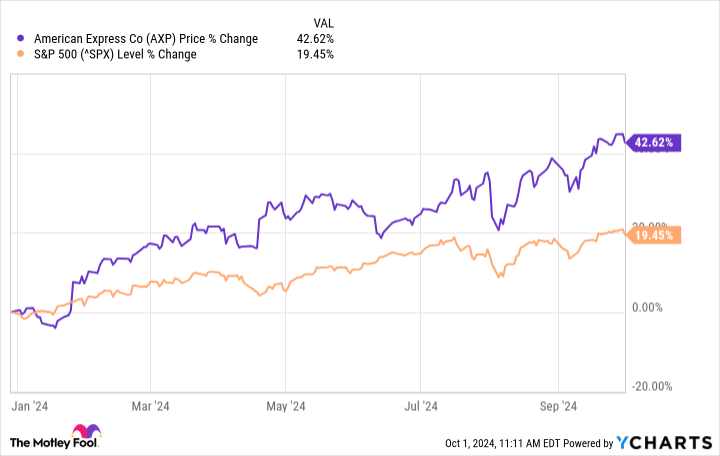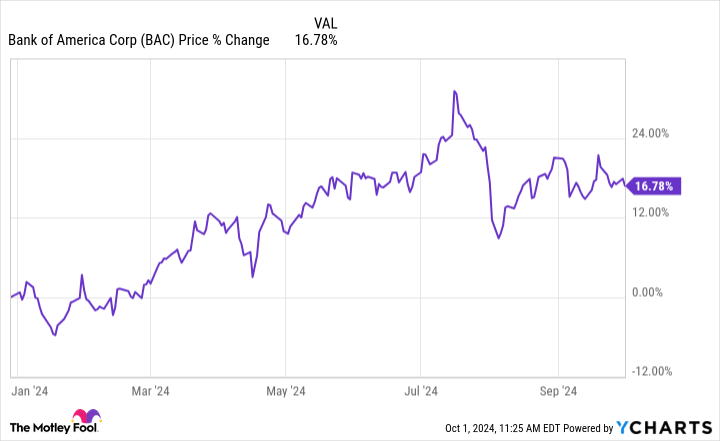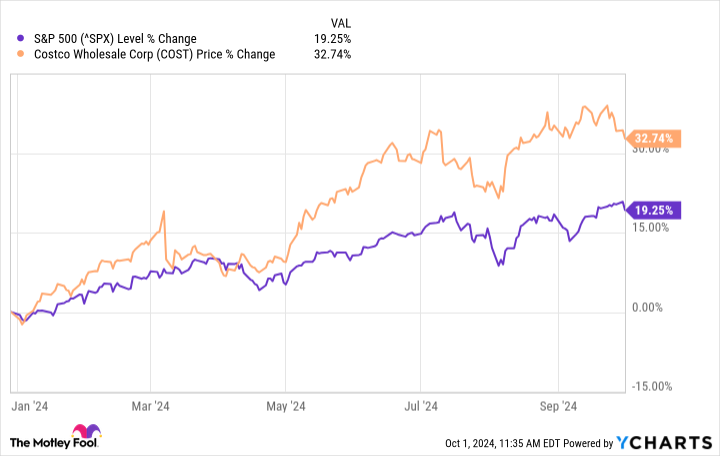5 Best Dividend Growth Stocks to Buy in October
October often brings both opportunity and volatility to the stock market. For investors seeking stability and income, dividend growth stocks can offer a compelling option in this dynamic market. These companies typically have strong financials, steady cash flows, and business models resilient enough to support consistent dividend increases.
Here are five top dividend growth stocks to consider this October. Spanning various sectors from technology to consumer discretionary, each pick is analyzed based on its dividend history, recent financial performance, and future growth prospects. Whether you're looking to reinvest dividends or generate a steady income stream, these stocks might be worth adding to your portfolio this fall.

1. AbbVie: A pharmaceutical powerhouse with a high yield
AbbVie (NYSE: ABBV) has outperformed the S&P 500 this year with a 27.2% gain, compared to the index's 19% rise. This outperformance is notable, given the challenges many pharmaceutical companies face with patent expirations and drug development.
The company's attractive 3.14% yield, more than double the S&P 500's average of 1.32%, stands out among dividend stocks. However, the 202% payout ratio raises significant concerns about the sustainability of the dividend. This unusually high payout ratio suggests that AbbVie is currently paying out more in dividends than it earns in profits, which is not sustainable in the long term.
AbbVie's forward price-to-earnings ratio (P/E) of 16.4 is relatively low in today's premium-laden market, reflecting the market's cautious stance on the company's transition from Humira to newer drugs like Skyrizi and Rinvoq.
This transition is critical, as Humira, AbbVie's top-selling drug since 2013, faces biosimilar competition. The projected 5.3% top-line growth for the next fiscal year, while modest, indicates that AbbVie expects Skyrizi and Rinvoq to effectively offset Humira's declining sales in the coming year. Early results from this transition have been promising, suggesting AbbVie's strategy to replace Humira's revenue stream is indeed on track.
That said, investors should watch AbbVie's debt levels closely. The 10.4 debt-to-equity ratio is high and could limit financial flexibility.
2. American Express: Riding the wave of post-pandemic spending
American Express (NYSE: AXP) has been a standout performer, with its stock price surging 42.6% year to date, more than doubling the S&P 500's performance in 2024. This impressive growth reflects the company's strong positioning in the post-pandemic economy, benefiting from increased consumer spending and travel rebound.
While the 1.03% yield might not excite income investors, American Express's 10.4% three-year dividend growth rate tells a different story. This rapid dividend growth, coupled with a low 19.4% payout ratio, suggests that American Express is prioritizing shareholder returns while maintaining financial flexibility.
The projected 8.5% top-line growth for the next fiscal year is encouraging, indicating that American Express expects the current spending trends to continue. However, investors should be cautious of potential economic headwinds that could impact consumer spending and credit quality.
American Express's forward P/E of 18.2 suggests the stock isn't cheap, but it's not excessively priced, given its growth prospects. The company's focus on affluent customers and its closed-loop network provide competitive advantages that could justify this valuation.
3. Bank of America: A value play in the financial industry
Bank of America's (NYSE: BAC) stock has gained 16.8% this year, lagging behind the S&P 500's 19.4% rise. This underperformance might create an opportunity for value investors, especially considering the bank's attractive 2.62% yield and conservative 33.6% payout ratio.
The 7.4% three-year dividend growth rate demonstrates Bank of America's commitment to increasing shareholder returns. With a forward P/E of just 11, the stock appears undervalued compared to the broader market, possibly reflecting concerns about the financial industry following recent high-profile bank failures.
Bank of America's projected 4.5% top-line growth for the next fiscal year is modest but solid for a large bank. The company's diversified revenue streams and strong consumer banking franchise provide stability, while its investment banking division offers growth potential.
The debt-to-equity ratio of 1.1, while not alarming, suggests that Bank of America carries a significant amount of debt relative to its equity. However, this level of leverage is fairly common in the banking industry due to the nature of their business model, which involves borrowing money (deposits) to lend out and generate interest income. Banks are required to maintain a certain level of capital adequacy to mitigate risks and comply with regulatory requirements.
Given the industry context, shareholders shouldn't be overly concerned about Bank of America's leverage ratio, as long as the bank maintains a strong balance sheet, manages its risks effectively, and generates consistent profits.
4. Costco: A premium-priced retail powerhouse
Costco's (NASDAQ: COST) stock has surged 32.7% year to date, significantly outperforming the S&P 500 in 2024. This market-beating performance reflects investor confidence in Costco's resilient business model. Moreover, the company's low debt-to-equity ratio of 0.35 underscores the retail giant's strong balance sheet and financial flexibility.
The stock's 0.52% yield might seem low, but Costco's 8.82% three-year dividend growth rate shows a strong commitment to increasing shareholder returns. The low 26.3% payout ratio suggests plenty of room for future dividend growth, although investors shouldn't expect Costco to become a high-yield stock overnight.
Costco's projected 6.7% top-line growth for the next fiscal year is impressive for a mature retailer, likely driven by new store openings and increased membership fees. The company's subscription-based model provides a steady revenue stream and customer loyalty that many retailers envy.
However, investors should be cautious of the lofty valuation. With a forward P/E of 50.2, Costco's stock is priced for perfection. While the company's track record justifies a premium, any missteps could lead to significant price corrections. Investors are paying a high price for Costco's quality and consistency.
5. Microsoft: A tech giant with room to grow
Microsoft (NASDAQ: MSFT) stock has gained 12% this year, trailing the S&P 500's performance. This relative underperformance might create an entry point for investors looking to gain exposure to Microsoft's diverse tech portfolio.
The 0.77% yield is modest, but the 6.8% three-year dividend growth rate shows Microsoft's commitment to increasing shareholder returns. With a low 24.8% payout ratio and strong cash flows, Microsoft has ample room to continue growing its dividend.
Microsoft's projected 14.3% top-line growth for the next fiscal year is impressive for a company of its size. This growth is likely driven by the continued expansion of Microsoft's cloud computing services (Azure) and integration of AI technologies across its product lines.
The forward P/E of 32.5 might seem high, but it's not unreasonable, given Microsoft's growth prospects and dominant market position. The company's low debt-to-equity ratio of 0.36 provides financial flexibility to invest in new technologies or pursue strategic acquisitions.
Investors should watch Microsoft's progress in AI integration, potential regulatory challenges, and competition in the cloud computing space. While Microsoft's diverse revenue streams provide stability, the tech sector's rapid evolution presents both opportunities and risks.
Should you invest $1,000 in AbbVie right now?
Before you buy stock in AbbVie, consider this:
The Motley Fool Stock Advisor analyst team just identified what they believe are the 10 best stocks for investors to buy now… and AbbVie wasn’t one of them. The 10 stocks that made the cut could produce monster returns in the coming years.
Consider when Nvidia made this list on April 15, 2005... if you invested $1,000 at the time of our recommendation, you’d have $744,197!*
Stock Advisor provides investors with an easy-to-follow blueprint for success, including guidance on building a portfolio, regular updates from analysts, and two new stock picks each month. The Stock Advisor service has more than quadrupled the return of S&P 500 since 2002*.
*Stock Advisor returns as of September 30, 2024
Bank of America is an advertising partner of The Ascent, a Motley Fool company. American Express is an advertising partner of The Ascent, a Motley Fool company. George Budwell has positions in AbbVie, Costco Wholesale, and Microsoft. The Motley Fool has positions in and recommends AbbVie, Bank of America, Costco Wholesale, and Microsoft. The Motley Fool recommends the following options: long January 2026 $395 calls on Microsoft and short January 2026 $405 calls on Microsoft. The Motley Fool has a disclosure policy.
5 Best Dividend Growth Stocks to Buy in October was originally published by The Motley Fool


